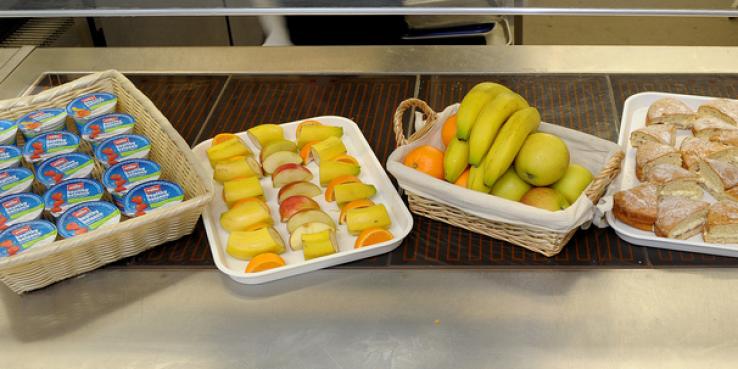San Francisco’s school meals could look quite a bit different in the coming years. That’s the overarching theme of a report that the San Francisco Unified School District (SFUSD) released in September. Produced by the design firm IDEO, which the district hired with a grant from the Sara and Evan Williams Foundation, the documents lays out a long-term vision for the future of SFUSD’s school meals program, which currently serves 22,000 lunches and 5,500 breakfasts each day.
The report’s 10 recommendations cover a wide variety of changes that would be implemented in phases over numerous years. Some of the proposals are bold and would require significant shifts from the status quo. Most prominent in this category is the idea of having elementary school students eat communally or “family style” rather than passing through a traditional lunch line that is more “food court” style. This new arrangement would provide a vastly different experience for young students and staff by allowing students more time to eat, a chance to learn healthy eating habits and more interaction with adults during lunch. The change, as the report notes, would require approval from state regulators and could also cost hundreds of thousands of dollars more than today’s operations.
On the operations side, the report proposes three changes in how food is delivered to students, each of which aims to increase food sales while reducing costs. One recommendation is to produce more school meals in-house, through a combination of a central warehouse and three large commissary kitchens. This change has the potential to reduce food costs by minimizing wasted inventory and cutting out some of the middlemen currently in the school food supply chain. It would also increase revenue through greater sales of meals produced by the district, which would provide a higher profit margin than the meals the district purchases from its current vendor, Revolution Foods. Complementing this change would be an increased use of “grab and go” kiosks and vending machines in middle and high schools. These would expand the number of places where students could purchase their lunch beyond the traditional lunch line, while not increasing labor costs significantly. The vending machine proposal has already been piloted on a small scale and has shown promising results. But the financial benefit of a central warehouse and regional kitchens is based on numerous assumptions that will need to be tested once implementation begins.
The clear cost-benefit analysis — which lays out assumptions of capital costs, ongoing costs and potential additional revenue from each recommendation — is what sets this new report apart from many earlier efforts to address the SFUSD school meals program. A report published by the San Francisco Food Bank in 2011 provided an overview of the state of the school meals program and, among other ideas, recommended that SFUSD explore a partnership with the Oakland Unified School District to produce meals. But it didn’t offer an in-depth analysis of what the cost and savings might be. Similarly, numerous important projects, such as adding salad bars to cafeterias, have been piloted within the district in the past few years, but they did not have the benefit of fitting into a broader vision for the school meals program.
The report clearly articulates a long-term vision for SFUSD’s school meals program and, importantly, also includes an implementation roadmap. As with any vision document, there are many steps that the district will need to take to get from the status quo to realizing the new school meals experience envisioned in the report. For example, the district will need to identify funding to adequately staff the current meals program while simultaneously putting resources toward pilot testing of the new ideas included in the report. It will have to resolve regulatory questions surrounding communal eating in elementary schools. And it will also have to negotiate with the district's union, SEIU 1021, regarding potential new roles and responsibilities for food service workers.
Despite these challenges, the district has more momentum on the issue of school food than it has in a long time. Last year, SFUSD shifted from purchasing frozen meals shipped halfway across the country to higher quality non-frozen meals produced by Revolution Foods in Oakland. The change led to a roughly 10 percent increase in student consumption of the meals, according to district staff. Behind the scenes, a new set of administrators and staff have taken the reins of the school meals program, providing new focus and energy on the issue. This helped lay the groundwork for the partnership with the Sara and Evan Williams Foundation, as well as IDEO, and it is the foundation upon which the implementation of the vision will be built. There is a tremendous amount of work to be done going forward, but with its new vision, SFUSD has now publicly set its sight on a goal and provided the school board and the public with its assessment of the potential costs and benefits of various routes to reach that goal.
